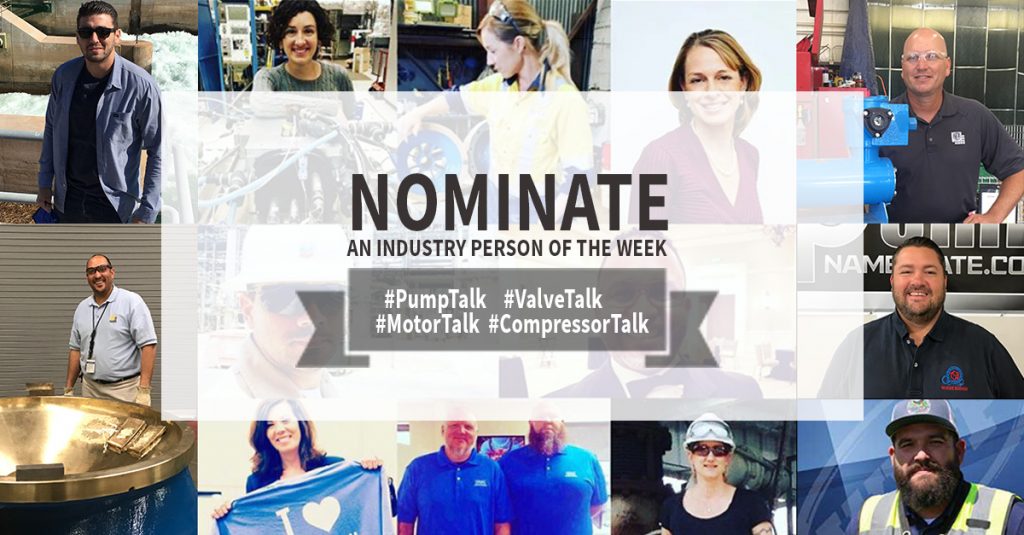Empowering Motors began inviting people to Nominate an Industry Professional, and we’ve seen so many people nominate their peers- it’s truly inspiring! Today’s Motor Person of the Week is Tim Albers with Nidec Motor Corporation. In this interview below, Tim shares some great info about voltage drop, bearing life calculations, NEMA premium efficiency, VFDs, and how he got started in the Pump Industry.
Q. How did you get started working in the Industry?
Tim: I started learning about pumps while I was a Navy Officer. I went through the Navy engineering program and then was assigned as an engineer on a ship. During my training with the Navy, the operation and maintenance of pumps and pumping systems was covered extensively. When I left active duty, I was recruited by General Electric in the Motors and Drives group and have been working with motors, with an emphasis in supporting the pump market, for almost 30 years.
Q. What is your favorite part of your job? What are you most proud of?
Tim: I am going to answer with two favorites. My first is solving an application problem. When an application can get complex, particularly with variable speed, working with a group to create a solution is very gratifying. The second is creating something entirely new. Working on and watching a concept or idea through development, tooling and then into production – then to see it used by customers – is a very proud moment. Not quite as proud as a parent, but very similar!
Q. What advice would you give to someone new to the industry?
Tim: Get involved. Find a group or a niche in the industry where you can get involved beyond just in your job. There are many industry groups and even environmental organizations that could use your skills or input. Those types of opportunities will always make the work more satisfying.
Q. Can you tell us about a cool project you worked on?
Tim: Nidec recently launched a new IoT platform for monitoring vibration and temperature with more sensors to come. That project came from an idea some of us had a few years ago. I spent a great deal of time talking to customers, vendors, industry experts and others to create a specification and then launch the new product development. Many of us have heard about and talked about IoT for many years, but to get to see something go from an idea to a fully functioning system that customers are now using to monitor pumps and other equipment is really cool!
Q. What are the top 5 questions you get asked by your customers? How do you answer them?
Tim: (1) Why do I hear people talk about NEMA Premium efficiency but also references to numbers like IE3? Are they the same thing?
To answer this question, the USA, Canada, and Mexico all mostly follow NEMA standards for electric motors. NEMA defines motors using tables with descriptions t
hat include Energy Efficient and Premium Efficient. In Europe and much of the world, the motor specification is based on IEC standards. Within IEC, the efficiencies are referred to by a numbering system. IE2 is basically the equivalent of the NEMA Energy efficient, and IE3 is equivalent of the NEMA Premium efficiency. There are some subtle differences, but to industry they are the same. That is why many motors suppliers and consumers pretty much refer to motors interchangeably as Premium efficient or IE3, for example.
(2) What is the efficiency standard for ‘this or that’ country? Each country can and does have different efficiency standards that have to be met. At Nidec, we work to keep an on-line engineering system up-to-date with each requirement as it changes. Without going into details, it is a tangled web of regulations that varies greatly by country. In some cases, I can give a clear and concise answer. In others, not so much. In general, most large and industrialized nations have

moved to at least energy efficient (IE2). Many countries have also moved to Premium efficient (IE3), but exceptions abound and that is where confusion can and does set in.
(3) Is it always better to run a motor on a VFD? The verbiage of the question can vary slightly, but the point of the question is around optimizing an application. There has been so much discussion in the industry around putting drives on applications that in some cases it may just seem to be the default. Particularly, for pump applications, that is very true, but the one thing to remember is that the losses operating a VFD must be accounted for. I bring this up in application discussions frequently. Adding the ability to run across the line when the pump even approaches full load speed can save significant energy over simply staying on the VFD. It seems like it could be trivial in the grand scheme of system efficiency, but even small enhancements when the system is designed can pay large benefits long term.
(4) Can I put that motor on XX voltage? This question has not changed in over 25 years. The misunderstanding of system or transformer voltage versus motor nameplate voltage is common. Motors are designed and nameplated in a way that assumes a loss of voltage in the line between the transformer and the motor. Some of the standard transformer voltages in the US and Canada are 4160, 2400, 600, 480, 240 and 208. The matching motor nameplate voltages are 4000, 2300, 575, 460, 230 and 200 volts. There are so many requests for a 480 volt motor for example. A 480 volt motor can be designed and manufactured, but NEMA, CSA, UL and NEC all assume and design around a 460 volt motor being applied on a 480 volt transformer driven system. The main item to know is that the cabling from the transformer to a motor will cause voltage drop. Exactly how much depends on the resistance of the cable and the length of the run. That is why motors are designed with that voltage drop in mind.
(5) Why do bearing life calculations vary so much by motor manufacturer? Bearing life is actually a fairly simple calculation based on rotations of the balls or rollers in the bearings and the stress level applied to them. Based on having the exact same type of bearing in a motor, it would seem that the life calculations would always be the same or very similar. That would be true if not for the application or non-application of life factors. Simple bearing calculations assume the lubrication is fixed at the start and never replenished. So, the calculation at that point assumes the lubricant is used up as well as the bearing rolling elements experiencing wear. When life factors are applied, it takes into account a replenishment with clean lubricant to the bearing. The percentage or increase to the bearing can vary widely when applying life factors, but on average it can easily add 2X or even 3X the life of the simple calculation. Obviously, a pump OEM or end user seeing the same bearing being used in a technical submittal with two or three times difference in calculated bearing life would cause questions for one or both manufacturers. Be aware of the application of life factors. It really makes a difference.
Tim, on behalf of the entire Empowering Motors team, thank you for your contributions to the industry! We look forward to keeping up with you through the #MotorTalk Community!

Know an Amazing Person who is making valuable contributions within the Pump Industry? Nominate them to be “Industry Person of the Week”!




